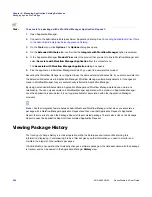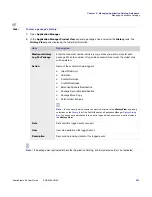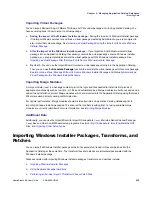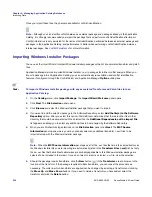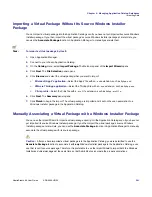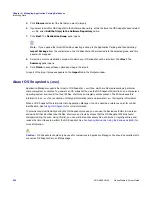
Chapter 6: Managing Application Catalog Databases
Importing Data
236
ADS-0950-UG00
AdminStudio 9.5 User Guide
About Transforms (.mst)
Application Manager supports the import of Windows Installer packages (
.msi
) with associated transforms (
.mst
).
A transform is a collection of changes applied to an installation. By applying a transform to a base installation
package, the installer can add or replace data in the installation database. The installer can only apply transforms
during an installation.
The installer registers a list of transforms required by the product during the installation. The installer must apply
these transforms to the product’s installation package when configuring or installing the product.
A transform can modify information that is in any persistent table in the installer database. A transform can also add
or remove persistent tables in the installer database. Transforms cannot modify any part of an installation package
that is not in a database table, such as information in the summary information stream, information in substorages,
information in nested installations, or files in embedded cabinets.
About Patches (.msp)
AdminStudio supports the import of Windows Installer packages (
.msi
) with associated patches (
.msp
). A Windows
Installer patch (
.msp
file) is a file used to deliver updates to Windows Installer applications. A patch is a self-
contained package that contains all the information required to update an application.
A patch package contains the actual updates to the application and describes which versions of the application
can receive the patch. A patch package does not include a database like a regular installation package (
.msi
file).
Patches contain at minimum two database transforms. One transform updates the information in the installation
database of the application. The other transform adds information that the installer uses for patching files.
Importing Virtual Packages
Edition •
Support for importing Microsoft App-V applications, ThinApp applications, and Citrix profiles into the
Application Catalog is included in the AdminStudio Virtualization Pack.
You can import Microsoft App-V, VMware ThinApp, and Citrix virtual packages into the Application Catalog and
associate them with their source Windows Installer package.
Virtual packages are self-contained entities which ordinarily cannot be modified after they are created. By
associating a virtual package with the Windows Installer package which originated it, you have the convenience of
being able to easily locate the virtual package’s originating Windows Installer package, modify the original
Windows Installer package, and then regenerate the virtual package.
You have several options in how to import a virtual package:
•
During the import of the Windows Installer package
—During the import of a Windows Installer package,
if the Import Wizard searches for and finds a virtual package created by AdminStudio, you are prompted to
also import that virtual package. See
Importing a Virtual Package During the Import of its Source Windows
Installer Package
.
Summary of Contents for ADMINSTUDIO 9.5
Page 1: ...AdminStudio 9 5 User Guide Version 9 5...
Page 50: ...Contents 50 ADS 0950 UG00 AdminStudio 9 5 User Guide...
Page 52: ...52 ADS 0950 UG00 AdminStudio 9 5 User Guide...
Page 156: ...156 ADS 0950 UG00 AdminStudio 9 5 User Guide...
Page 440: ...440 ADS 0950 UG00 AdminStudio 9 5 User Guide...
Page 1090: ...1090 ADS 0950 UG00 AdminStudio 9 5 User Guide...
Page 1426: ...1426 ADS 0950 UG00 AdminStudio 9 5 User Guide...
Page 1686: ...1686 ADS 0950 UG00 AdminStudio 9 5 User Guide...
Page 1794: ...Chapter 24 AdminStudio Public API Reference 1794 ADS 0950 UG00 AdminStudio 9 5 User Guide...
Page 1842: ...Index 1842 ADS 0950 UG00 AdminStudio 9 5 User Guide...





